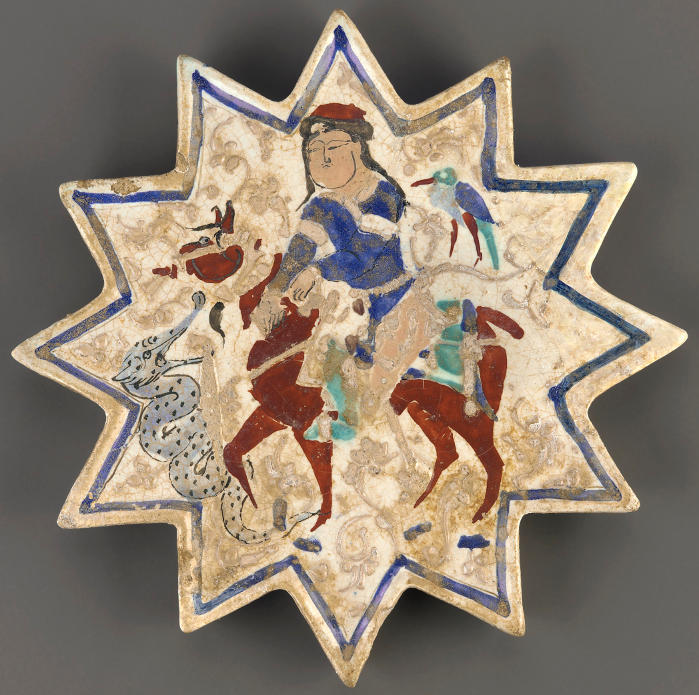
Create an Amazon Wedding Registry
Seljuk Star, Kashan, Iran, late 12th century
Rustam and the Dragon

A larger image of this Seljuk Star with Rustam and the Dragon, late 12th century.


HISTORICAL PERIOD: Saljuq period, late 12th century
MEDIUM: Stone-paste painted with enamel (mina'i)
DIMENSIONS: H x W: 18.3 x 1.7 cm (7 3/16 x 11/16 in)
GEOGRAPHY: Iran, Kashan
ACCESSION NUMBER: F1911.319
Freer Gallery F1911.319.
Referenced as figure 374 in The military technology of classical Islam by D Nicolle
374. Ceramic tile, late 12th century AD, Iranian, Freer Gallery of Art no. 11.319, Washington (At).
While the Turcomans of Rūm were downgraded in the face of Byzantine influence, those of Iran and the Fertile Crescent enjoyed an even briefer era of political and military supremacy. The huge realm of the Great Saljūqs started to fragment even before the end of the 11th century, before, in fact, the Crusaders appeared in the Middle East. Although this dynasty retained control of parts of Iran and Iraq until the late 12th century, larger areas fell to various successor dynasties. These did, however, generally continue the Saljūq system within their armed forces. Yet it would already be quite wrong to see such Saljūq military traditions as Turcoman. Saljūq forces were early divided into two distinct parts, a small professional ʿaskar of mamlūks or mercenaries who owed allegiances to whichever ruler or local governor recruited them, and a larger element of tribal auxiliaries of whom the Turcomans were the most effective element. While the ʿaskars formed a standing army of cavalry and infantry, garrison troops and personal guards, the auxiliaries would only be called upon for a specific campaign.20 That this process started soon in the history of the Saljūq state may be inferred from the fact that the Great Saljūq Sultan, Ṭughril Beg, was using siege engines as early as 1054 AD during his first unsuccessful attack on Manzikert.
The varied equipment of a Saljūq regional ʿaskar is probably illustrated on an early 13th century carved gateway from Sinjār (fig. 280). Other sources which may also illustrate professional ʿaskaris are to be found in 12th century Iran (Figs. 367, 368, 370, 371, 374 and 381, 382 & 383). The best description of Saljūq equipment, in this case probably referring to 11th or 12th century Turcomans rather than to an ʿaskar,21 is to be found in the romance of Warka wa Gulshāh. Here the weapons include javelin, spear, sward, bow, mace and lassoo, while armour is comparably heavy, including helmet, coif or aventail, and full hauberk.22 The late 12th century illustrations of this Warka wa Gulshāh manuscript correspond in most points to its slightly earlier text (fig. 422 ), Such equipment is mirrored, either exactly or with minor variations, in other Iranian and neighbouring sources (figs. 377, 378, 305, 424 and 425).
20. Smail, op. cit., pp. 66-67.
21. Ayyūqī, pp. cit., pp. 5-6 21-23 and 29.
22. Ibid,. pp. 38-39 and passim.